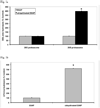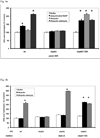Ubiquitinated proteins activate the proteasome by binding to Usp14/Ubp6, which causes 20S gate opening
- PMID: 20005843
- PMCID: PMC2796264
- DOI: 10.1016/j.molcel.2009.11.015
Ubiquitinated proteins activate the proteasome by binding to Usp14/Ubp6, which causes 20S gate opening
Abstract
In eukaryotic cells, ubiquitination of proteins leads to their degradation by the 26S proteasome. We tested if the ubiquitin (Ub) chain also regulates the proteasome's capacity for proteolysis. After incubation with polyubiquitinated proteins, 26S proteasomes hydrolyzed peptides and proteins 2- to 7-fold faster. Ub conjugates enhanced peptide hydrolysis by stimulating gate opening in the 20S proteasome. This stimulation was seen when this gate was closed or transiently open, but not maximally open. Gate opening requires conjugate association with Usp14/Ubp6 and also occurs if Ub aldehyde occupies this isopeptidase's active site. No stimulation was observed with 26S from Ubp6Delta mutants, but this effect was restored upon addition of Usp14/Ubp6 (even an inactive Ubp6). The stimulation of gate opening by Ub conjugates through Usp14/Ubp6 requires nucleotide binding to the gate-regulatory ATPases. This activation enhances the selectivity of the 26S proteasome for ubiquitinated proteins and links their deubiquitination to their degradation.
Figures









Similar articles
-
The deubiquitinating enzyme Usp14 allosterically inhibits multiple proteasomal activities and ubiquitin-independent proteolysis.J Biol Chem. 2017 Jun 9;292(23):9830-9839. doi: 10.1074/jbc.M116.763128. Epub 2017 Apr 17. J Biol Chem. 2017. PMID: 28416611 Free PMC article.
-
Ubiquitinated proteins activate the proteasomal ATPases by binding to Usp14 or Uch37 homologs.J Biol Chem. 2013 Mar 15;288(11):7781-7790. doi: 10.1074/jbc.M112.441907. Epub 2013 Jan 22. J Biol Chem. 2013. PMID: 23341450 Free PMC article.
-
Ubiquitinated proteins promote the association of proteasomes with the deubiquitinating enzyme Usp14 and the ubiquitin ligase Ube3c.Proc Natl Acad Sci U S A. 2017 Apr 25;114(17):E3404-E3413. doi: 10.1073/pnas.1701734114. Epub 2017 Apr 10. Proc Natl Acad Sci U S A. 2017. PMID: 28396413 Free PMC article.
-
Mechanisms That Activate 26S Proteasomes and Enhance Protein Degradation.Biomolecules. 2021 May 22;11(6):779. doi: 10.3390/biom11060779. Biomolecules. 2021. PMID: 34067263 Free PMC article. Review.
-
Proteasomes and their associated ATPases: a destructive combination.J Struct Biol. 2006 Oct;156(1):72-83. doi: 10.1016/j.jsb.2006.04.012. Epub 2006 May 8. J Struct Biol. 2006. PMID: 16919475 Review.
Cited by
-
Redox control of 20S proteasome gating.Antioxid Redox Signal. 2012 Jun 1;16(11):1183-94. doi: 10.1089/ars.2011.4210. Epub 2012 Mar 6. Antioxid Redox Signal. 2012. PMID: 22229461 Free PMC article.
-
Mode of targeting to the proteasome determines GFP fate.J Biol Chem. 2020 Nov 20;295(47):15892-15901. doi: 10.1074/jbc.RA120.015235. Epub 2020 Sep 10. J Biol Chem. 2020. PMID: 32913119 Free PMC article.
-
Proteasome stress responses in Schistosoma mansoni.Parasitol Res. 2015 May;114(5):1747-60. doi: 10.1007/s00436-015-4360-z. Epub 2015 Feb 10. Parasitol Res. 2015. PMID: 25663105
-
Measurement of the Multiple Activities of 26S Proteasomes.Methods Mol Biol. 2018;1844:289-308. doi: 10.1007/978-1-4939-8706-1_19. Methods Mol Biol. 2018. PMID: 30242717 Free PMC article.
-
26S proteasomes become stably activated upon heat shock when ubiquitination and protein degradation increase.Proc Natl Acad Sci U S A. 2022 Jun 21;119(25):e2122482119. doi: 10.1073/pnas.2122482119. Epub 2022 Jun 15. Proc Natl Acad Sci U S A. 2022. PMID: 35704754 Free PMC article.
References
-
- Bajorek M, Finley D, Glickman MH. Proteasome disassembly and downregulation is correlated with viability during stationary phase. Curr Biol. 2003;13:1140–1144. - PubMed
-
- Bech-Otschir D, Helfrich A, Enenkel C, Consiglieri G, Seeger M, Holzhutter HG, Dahlmann B, Kloetzel PM. Polyubiquitin substrates allosterically activate their own degradation by the 26S proteasome. Nat Struct Mol Biol. 2009;16:219–225. - PubMed
-
- Benaroudj N, Zwickl P, Seemuller E, Baumeister W, Goldberg AL. ATP hydrolysis by the proteasome regulatory complex PAN serves multiple functions in protein degradation. Mol Cell. 2003;11:69–78. - PubMed
Publication types
MeSH terms
Substances
Grants and funding
LinkOut - more resources
Full Text Sources
Other Literature Sources

